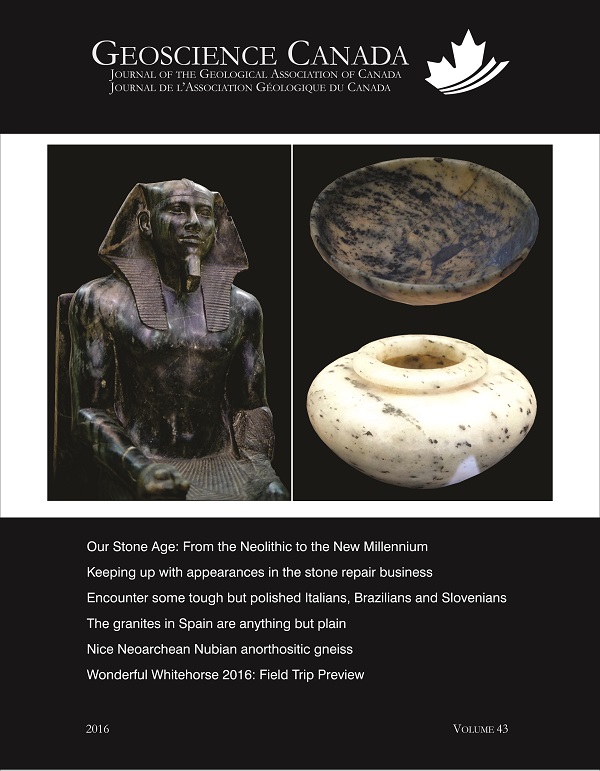Series
Heritage Stone 7. Pohorje Granodiorite – One of the Most Significant Slovenian Natural Stones
Publié-e 2016-03-14
Comment citer
Kramar, S., Trajanova, M., Dolenec, M., Gutman, M., Bedjanič, M., & Mladenovič, A. (2016). Heritage Stone 7. Pohorje Granodiorite – One of the Most Significant Slovenian Natural Stones. Geoscience Canada, 43(1), 79–88. https://doi.org/10.12789/geocanj.2015.42.077
Résumé
Granodiorite from the Pohorje Mountains (northeastern Slovenia) is considered the highest quality natural stone in Slovenia. Pohorje granodiorite is a grey, calc-alkaline igneous rock of Miocene age (18.7 Ma) that is distinguished by thick white aplite−pegmatite veins. It mainly consists of plagioclase, quartz, and K-feldspar, subsidiary biotite and a small amount of hornblende. It is characterized by high density, low water absorption, and low porosity, so that it exhibits high frost and salt resistance, as well as a high compressive strength and a very high flexural strength. It is widely recognized throughout the country for its durability and decorative white veins, and is the most frequently used natural stone in Slovenia today. It is mainly used as paving and cladding material for residential buildings, churches, and other structures, as well as in public areas, where it adds special character to many of the larger towns and cities. Several important buildings, some of which have been declared cultural monuments of national importance, are also decorated with this stone, including the Slovenian Parliament, the Republic Square business complex, and the Faculty of Law of the University of Ljubljana, all of which are located in Ljubljana. Since 1940, Pohorje granodiorite has also been widely used by sculptors in various monuments and fountains.RÉSUMÉ
Le granodiorite des montagnes de Pohorje (nord de la Slovénie) est considéré comme la meilleure pierre naturelle de Slovénie. Le granodiorite de Pohorje est une roche ignée grise, calco-alcaline du Miocène (18,7 Ma) qui se distingue par la présence d’épais filons de pegmatites d’aplite blanche. Il se compose principalement de plagioclase, de quartz et de feldspath potassique, de biotite accessoire et d’une petite quantité d'amphibole. Elle est caractérisée par une densité élevée, un faible coefficient d’imbibition, et une porosité faible, de sorte qu'elle présente une haute résistance au gel et au sel, ainsi qu’une résistance élevée à la compression et une résistance très élevée à la flexion. Elle est très connue dans tout le pays pour sa durabilité et ses filons décoratifs blancs, et c’est la pierre naturelle la plus fréquemment utilisée en Slovénie de nos jours. Elle est principalement utilisée comme matériau de pavage et de revêtement pour les bâtiments résidentiels, les églises et autres constructions, ainsi que dans les espaces publics, où elle donne un caractère distinctif aux grands villages et aux villes. Plusieurs bâtiments importants, dont certains ont été déclarés monuments culturels d'importance nationale, sont également décorées avec cette pierre, y compris le Parlement slovène, le complexe d'affaires Place de la République, et la Faculté de droit de l'Université de Ljubljana, lesquels sont tous situés à Ljubljana. Depuis 1940, le granodiorite de Pohorje a aussi été beaucoup utilisé par les sculpteurs dans divers monuments et fontaines.
Traduit par le Traducteur
